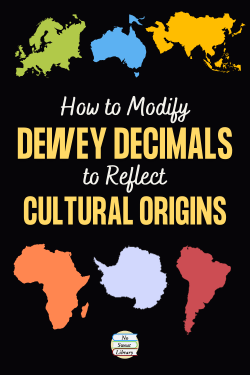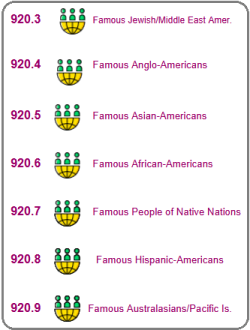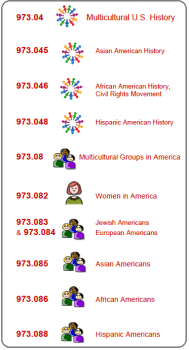 When I became the School Librarian at our district’s most diverse middle school (1/3 African-American, 2/3 equally Hispanic, Anglo, and Asian), I quickly realized the limitations of our collection and of the Dewey Decimal Classification System for making a culturally responsive collection.
When I became the School Librarian at our district’s most diverse middle school (1/3 African-American, 2/3 equally Hispanic, Anglo, and Asian), I quickly realized the limitations of our collection and of the Dewey Decimal Classification System for making a culturally responsive collection.
I had questions similar to those of another librarian in an LM_NET listserv post:
“I want my collection to equitably reflect my students and their world, and am bothered by racial and cultural biases in the Dewey Decimal Classification System, in the Library of Congress Subject Headings, and other systems. … how do you combat systemic marginalization in the organization and classification of your collection? Do you reorganize your collection to reflect the population you serve, or pull books about particular groups or subjects together, while retaining Dewey classification and adding spine labels/stickers?”
Pondering the DDC difficulty, I perused my Abridged print copy and discovered how to use the Dewey system to better serve our school’s diverse population. It answers questions in the listserv post, and I suspect it will resolve your concerns as well..
ADJUST DEWEY NUMBERS TO REFLECT CULTURES
Our first responsibility as School Librarians is to make the school library student-friendly, so we can make changes to help students find what they need!  There are no “Dewey Police” that punish us for changing a book’s Dewey number. In fact, OCLC regularly makes changes to DDC to meet the changing needs of our society. And changing Dewey to meet the needs of our students fulfills the very purpose of DDC: “works that are used together to be found together.”
There are no “Dewey Police” that punish us for changing a book’s Dewey number. In fact, OCLC regularly makes changes to DDC to meet the changing needs of our society. And changing Dewey to meet the needs of our students fulfills the very purpose of DDC: “works that are used together to be found together.”
I don’t worry about changes because few librarians really know enough DDC numbers past the 10 main Classes to be confused by my changes. In fact, no one really has to “know” an organization system to locate any book in any library—we locate an item using the Call Number listed in an OPAC search, and that’s what our students do. I prefer to be a “creative Dewey-ist”, in that I’ll always change a Dewey number to put a book where it is relevant to our school curriculum.
 With my student demographics in mind, I noticed the DDC Table 2 Geographic Areas lists numbers for earth’s continents to use in DDC numbers (it’s that second number right after the 9 in the 900s). I decided to use these numbers as “continent of origin” numbers for cultural/ethnic groupings and adjust Dewey numbers to reflect cultural origins:
With my student demographics in mind, I noticed the DDC Table 2 Geographic Areas lists numbers for earth’s continents to use in DDC numbers (it’s that second number right after the 9 in the 900s). I decided to use these numbers as “continent of origin” numbers for cultural/ethnic groupings and adjust Dewey numbers to reflect cultural origins:
- 3=Jewish & other Semitic groups (Ancient Worlds includes Palestine)
- 4=European or Anglo
- 5=Asian
- 6=African
- 7=North American or Native Nations
- 8=South American or Hispanic/Latino.
Though Mexico, Central America, and the Caribbean are included in North America, I chose to include them here for cultural identity & to avoid confusion with books about U.S./Canada & Europe. - 9=Australasia and the south Pacific islands
HOW I CREATED SPECIAL MULTICULTURAL COLLECTIONS
In my school library collection, there are 3 Dewey sections with a large number of books related to cultural, ethnic, and racial topics:
- the 300s, notably 305 Social Groups, 306 Culture & Institutions, and 398 Folklore
- the 920 Collected Biographies
- the 973 U.S. History section
398 Folklore
I had already made significant rearrangements to 398 Folklore, and I decided using 398.2089 for ethnic/national groups was way too many decimals, so instead I use 398.23 Folk Literature of Places & Times and add my continent of origin designations to create 398.23 Multicultural Folktales. What a remarkable difference that makes to our sizable folklore collection! It’s now so much easier to use, especially when I need to pull books for lessons or for classroom use.
- 398.231 Non-specific or mixed folktales
- 398.233 Jewish & other Semitic folktales
- 398.234 European folktales
- 398.235 Asian folktales
- 398.236 African & African American folktales
- 398.237 Native Nations folktales
- 398.238 Hispanic/Latino & Hispanic American folktales
- 398.239 Australia/Oceania folktales
920 Collected Biographies
 I had also begun to redo the 920 Collected Biographies, using 921-928 for Subjects according to DDC 920 Option A. I decided to make 920.3-920.9 “Multicultural Collected Biographies” by adding the pertinent continent number to the right of the decimal.
I had also begun to redo the 920 Collected Biographies, using 921-928 for Subjects according to DDC 920 Option A. I decided to make 920.3-920.9 “Multicultural Collected Biographies” by adding the pertinent continent number to the right of the decimal.
I barely got the section reorganized before kids noticed all the new groupings and began checking out books that had never before circulated. And they thanked me for getting all those “new” books! Chalk one up for my new 920 Multicultural Collection.
973 U.S. History
When I tackled 973 U.S. History, I noticed DDC Table 1 Standard Subdivisions designates .04 as Special topics. The Library of Congress catalogs African American history books with 973.04__, so I decided to use 973.04 for Multicultural U.S. History & Events, adding a continent of origin number after the 4. Also, Table 1 has .08 Groups of People, so I used 973.08 for Multicultural American Groups, adding the continent of origin number after the 8.
 I also gathered relevant books from other Dewey sections, made new spine labels with the cultural designation, and now had 3 shelves of books for our new Special Multicultural America Collection:
I also gathered relevant books from other Dewey sections, made new spine labels with the cultural designation, and now had 3 shelves of books for our new Special Multicultural America Collection:
- 973.045 became Asian-American History
- 973.046 became African-American History (including the Civil Rights Movement)
- 973.048 became Hispanic-American History
- 973.083 for Jewish-Americans in the US
- 973.085 for Asian-Americans in the US
- 973.086 for African-Americans in the US
- 973.088 for Hispanic-Americans in the US
- I also added 973.082 for Women in America
I did not put books on U.S. slavery in these collections. Instead I used 973.714 to place them in the Civil War numbers since that’s when the topic is studied in 8g Social Studies. I pulled many books from the 300s and other sections to expand that section. In fact, I had pulled so many books from 305 Social Groups and 306 Culture & Institutions for the new U.S. History topics, that the remaining books were fewer and more relevant as global topics, so I didn’t need to make any changes there.
KEEPING UP WITH NEW BOOKS
Some may worry about the time required to redo book spine labels and change catalog call numbers for new multicultural Dewey books, but we rarely order more than a few at a time. The next librarian will know exactly what to do because I have detailed explanations in my Librarian’s Handbook. As it turns out, every school librarian to whom I’ve shown my changes has loved the idea, especially that students find these books and check them out like crazy!
| If you want the colorful shelf labels shown above, get them in my Dewey Decimal Signs & Shelf Labels product, available from No Sweat Library, my TeachersPayTeachers store. |  |

